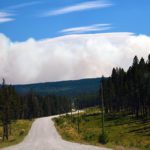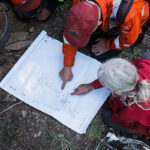Home »

The Indomitable Prairie Crocus
Op-Ed Commentary
The word “fragile” is often used to describe wildflowers. They certainly appear to fit the word. Usually looked on as small, delicate plants with fine components such as stamens and pistils precariously perched among thin petals. Many have intricate leaves that are easily crushed underfoot and susceptible to frosts and late snows.
I’ll argue that spring wildflowers are remarkably tough. Hardy just begins to describe a plant that emerges as soon as frost leaves the ground, often rising through late-winter snows or melting drifts. Anything that is able to withstand frequent frost and occasionally being buried by snow is decidedly not ‘fragile.’
The prairie crocus is one of the best-known early flowers of our valley bottom grasslands and open forests. They are a poster child for why botanists use scientific names (in this case Anenome patens, if you were wondering) as the flower is confusingly known by a number of monikers including pasqueflower, windflower and several others. In Ktunaxa, it is known as ʔinq̓um. Although they resemble their namesake early bulb-borne blooms of gardens and flowerpots, it is not a true crocus which are a type of iris. Rather, prairie crocus is in the buttercup family, more closely related the mop-topped seed head western anemone, common in alpine meadows.
At first, just the bloom emerges, calling on energy stored in the plant’s extensive taproot system. Ranging from deep purple through light mauve to white, often on the same plant, they bring an early splash of colour to an otherwise drab landscape of browns and greys.
Leaves, being more susceptible to damage by frost, come later with (slightly) more reliable weather. The blooms then go to seed and drift off at the whims of a breeze. The leaves photosynthesize the energy needed for the next year’s blooms, then whither before summer’s heat begins and the plant get overshadowed by taller grasses. By July, the plant is dormant with a year’s worth of energy stored in the plant’s vast taproot system, waiting for next spring’s show time.
 ʔinq̓um has many adaptations to its early season rising. Spring, of course, is the most fickle of seasons. Warm and sunny one day while snowing the next, so heat-retention is important. Like many other flowers, the blooms track the movement of the sun across the open grassland sky over the course of the day. This keeps sunlight directly on the disc-shape flowers that help trap heat. The petals have reflective qualities that focus heat onto the yellow stamens and grey pistils at the bloom’s centre. This can raise the temperature within the crocus bloom by as much as 10°C which warms these important reproductive parts of the flower. The heat also attracts insects on an otherwise cool spring day, which then pollinate the flowers as they move from bloom to bloom.
ʔinq̓um has many adaptations to its early season rising. Spring, of course, is the most fickle of seasons. Warm and sunny one day while snowing the next, so heat-retention is important. Like many other flowers, the blooms track the movement of the sun across the open grassland sky over the course of the day. This keeps sunlight directly on the disc-shape flowers that help trap heat. The petals have reflective qualities that focus heat onto the yellow stamens and grey pistils at the bloom’s centre. This can raise the temperature within the crocus bloom by as much as 10°C which warms these important reproductive parts of the flower. The heat also attracts insects on an otherwise cool spring day, which then pollinate the flowers as they move from bloom to bloom.
Most noticeable on prairie crocuses are the hairs that cover the entire plant, including the flowers. These are, of course, not true hairs in the sense of us mammals. More accurately called trichomes, they are simply outgrowths of the plant that provide double duty for prairie crocuses. The main function is to reduce wind and air movement directly on the plant. This not only provides a layer of insulation to trap warm air close to plant but just as importantly helps the plant retain valuable moisture. Given the semi-arid grasslands where prairie crocus thrives and the water-eating winds they must endure, this is a key adaptation. Conveniently, it also makes for wonderful back-lit photographs.
The strategies are effective. The indomitable prairie crocus is a long-lived plant, known to persist for over 50 years. They likely spread out too, up to 30 cm across. That’s a lot of springs for us to enjoy prairie crocus’ early colour. We should also admire their strength and resiliency, something we all could use these days.
Lead image: A prairie crocus bud. Photos by Ian Adams
Ian Adams is a wildlife biologist living near Cranbrook. He often lags behind on hikes to take photograph wildflowers.








